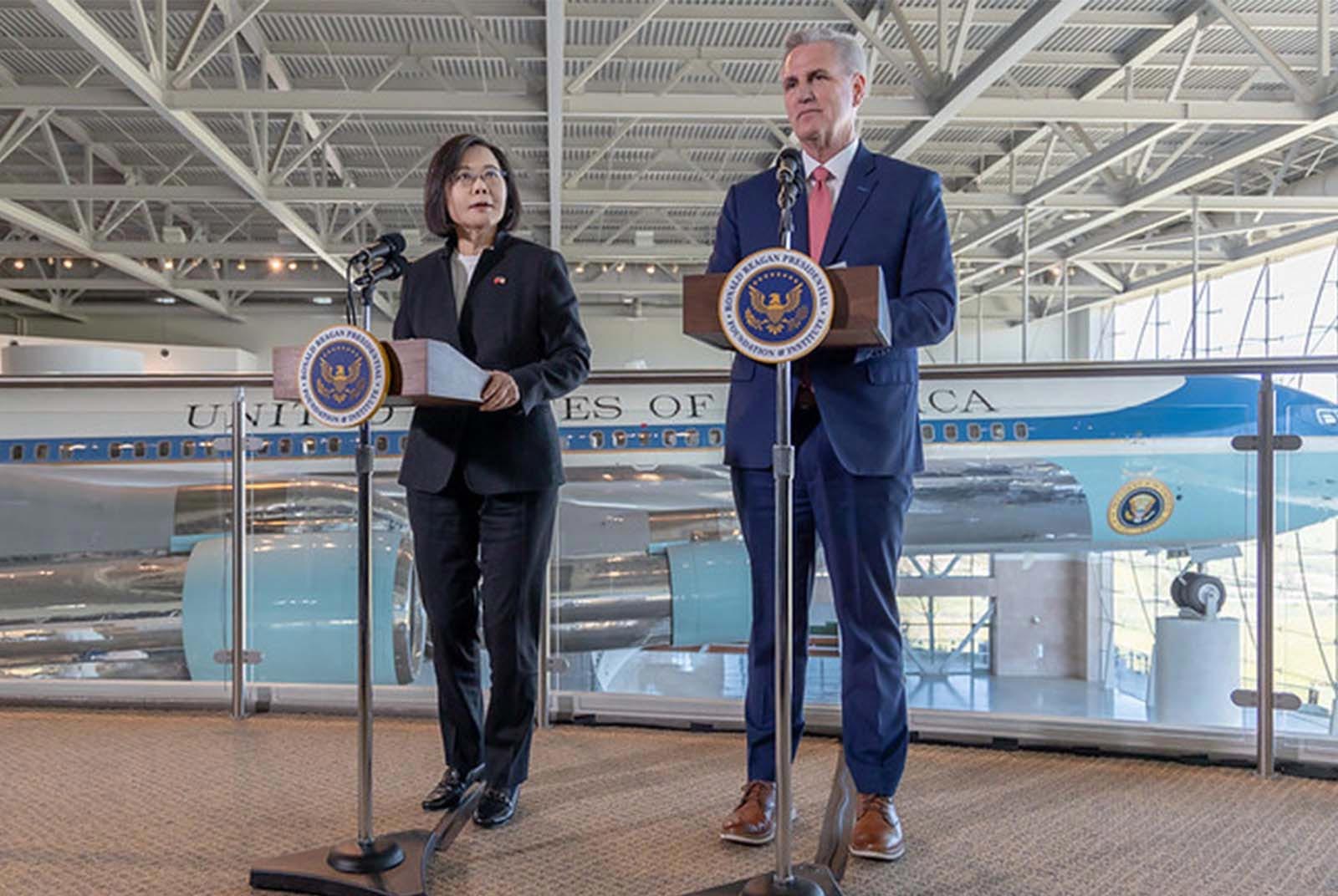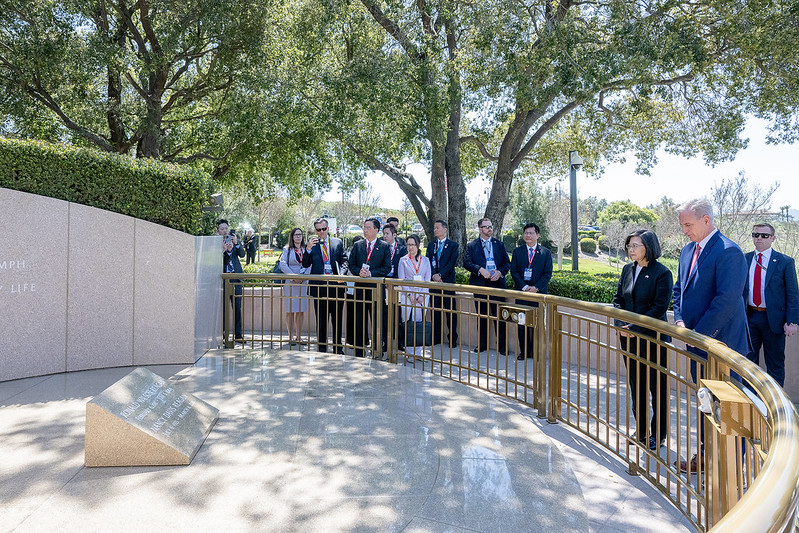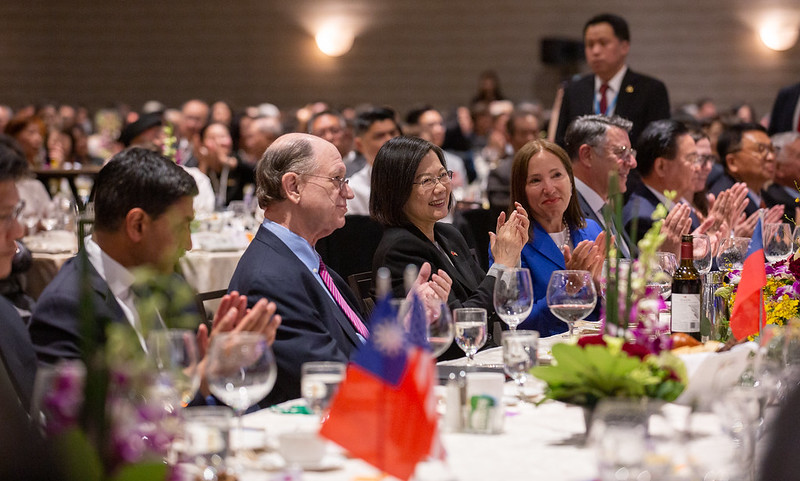After the Tsai-McCarthy meeting on 'tour of restraint': Three changes to US-Taiwan relations

Source:Office of the President Republic of China(Taiwan)
President Tsai Ing-wen became the first Taiwanese leader to meet with a U.S. Speaker of the House on American soil. Following her return from her 10-day itinerary, Beijing announced small-scale military exercises. What kind of new situation do these changes herald?
Views
After the Tsai-McCarthy meeting on 'tour of restraint': Three changes to US-Taiwan relations
By Silva Shihweb only
Taiwan President Tsai Ing-wen’s meeting with U.S. House Speaker Kevin McCarthy in California did not just make headlines in Taiwan. “It was talked about all over U.S. cable news channels during the evening primetime period,” said Eric Huang, former deputy Kuomintang (KMT) envoy in the United States, speaking from the U.S. East Coast.
From former U.S. President Donald Trump’s trade war with China to current President Joe Biden’s State of the Union address directly naming China as a competitor, to the “spy balloon” saga of this past February, popular American suspicion of China has reached a crescendo. Taiwan - one of the key points of contention between the U.S. and the PRC - has also attracted Americans’ attention.
“Support for Taiwan is a rare bipartisan area of consensus for America,” stated McCarthy, a Republican, during media questioning following his meeting with President Tsai.
Especially worth noting is that, unlike the tensions resulting from (then House Speaker) Nancy Pelosi’s visit to Taiwan last year, “One could say that there were no breakthroughs with this transit trip, and that it was restrained,” says Huang.
 President Tsai and U.S. Speaker of the House McCarthy (Source: Office of the President Republic of China(Taiwan))
President Tsai and U.S. Speaker of the House McCarthy (Source: Office of the President Republic of China(Taiwan))
Tour of restraint for US, Taiwan and China
Eric Huang described the trip as “restrained,” as Tsai Ing-wen’s public remarks stuck to Taiwan as the subject in the face of soaring distrust in China among the American audience, avoiding any inflammatory attacks on China.
Certain realistic considerations underlie Tsai Ing-wen’s caution.
Observers were concerned for a while that the meeting between Tsai and McCarthy would result in a similar situation as Pelosi’s previous visit to Taiwan, which led to the People’s Liberation Army (PLA) virtually sealing the island off with 72 hours of military exercises, putting the region on edge. However, after the Taiwanese leader’s 10-day U.S. excursion had ended, the reverberations never deviated appreciably from the scenarios that had been mapped out by Taiwan’s national security team.
In addition to announcing reprisals against organizations affiliated with Taiwan’s national security, like the Prospect Foundation and the Council of Asian Liberals and Democrats, along with sanctions targeting Taiwan’s representative to the U.S., Bi-khim Hsiao, and those affiliated with the Hudson Institute and the Reagan Library, Beijing announced that it would conduct three days of military exercises in the Taiwan Strait.
Like the previous time, the precise extent of the exercises was not announced; however, the scope was clearly reduced, so that the political significance outweighed the military intimidation.
Taiwan is walking on a wire, and a report by the National Committee on American Foreign Policy (NCAFP), a high-level U.S.-based think tank, revealed Taiwan’s difficult situation. A delegation of NCAFP members, including former AIT Chairman Raymond Burghardt, and former acting Assistant Secretary of State for East Asian and Pacific Affairs Susan Ashton Thornton, visited Taiwan last December, during which they met with President Tsai Ing-wen. Upon returning from their visit, the delegation issued a report, in which it wrote:
"The issue of foreign delegations visiting Taiwan was also discussed. Officials indicated that Taipei is in a difficult position and cannot refuse these visits, including an anticipated visit by U.S. House Speaker Kevin McCarthy. However, as the cost-benefit calculus of such visits evolves, Taipei is considering how it might better manage risks."
 (Source: Office of the President Republic of China(Taiwan))
(Source: Office of the President Republic of China(Taiwan))
How can the risks of visiting foreign delegations be managed?
“Lessons were learned from the Pelosi visit. This time (the Tsai administration) spent a lot of time communicating with both the U.S. and the PRC,” observes a former high-ranking national security insider.
As early as late last year, diplomatic circles were abuzz with word that new U.S. House Speaker, Kevin McCarthy, was planning to visit Taiwan. At the same time, news of President Tsai Ing-wen’s visit to the United States soon came out.
There were three stops on the public itinerary, demonstrating months of active discussion and communication by the U.S. and Taiwan
In February, Deputy Assistant Secretary of Defense, Michael S. Chase, visited Taiwan. Pentagon officials rarely disclose their itineraries, so this was unusual.
Shortly thereafter, Minister of Foreign Affairs Joseph Wu and National Security Council Secretary-General Wellington Koo headed to the headquarters of the American Institute in Taiwan (AIT) in Washington, D.C. for a closed-door meeting with U.S. officials including Deputy Secretary of State Wendy Sherman and Assistant Secretary of State for East Asian and Pacific Affairs Daniel Kritenbrink.
AIT is headquartered in Arlington, Virginia, just across the Potomac River from Washington, D.C. This meeting marked the first time since the U.S. and Taiwan severed official relations that Taiwan’s Minister of Foreign Affairs had entered the District.
At the same time, Taiwan’s representative to the U.S., Bi-khim Hsiao, made an unscheduled trip back to Taiwan for a debriefing. This was viewed by observers as Hsiao making the trip to discuss U.S. affairs in person.
Amanda Hsiao, senior analyst for China at the Belgium-based International Crisis Group, observes that Taiwanese officials actively worked with the Biden administration, ultimately reaching an agreement to have Tsai and McCarthy meet on U.S. soil. Beijing’s response was relatively guarded this time. In one sense, Beijing correctly interpreted Taipei and Washington’s intentions for warmer relations, while former President Ma Ying-jeou’s visit to China also served to lower the risks.
US about face: Risk management plus pragmatic support
It is worth noting that, although there were no surprises during President Tsai’s transit visit in the United States, the interaction on display during the trip showed observers three new directions in relations between the two countries.
First, as one senior American scholar at a think tank observed, the Biden administration is not engaging in symbolic gestures, but is also unable to provide substantive support for Taiwan that could provoke China. For instance, the joint consultation with Taipei to determine the location of the meeting with McCarthy, and the White House's efforts to remove sensitive clauses from the Taiwan Policy Act, such as treating Taiwan as a non-NATO ally, are clear signals from the Biden administration to Taiwan.
Nevertheless, at the same time, apart from using various public statements and behind-the-scenes actions with allies to put international pressure on Beijing as a deterrent, bringing in Taiwan as an economic ally is another approach of the Biden administration.
President of the U.S.-Taiwan Business Council, Rupert Hammond-Chambers, notes that in order to safeguard Taiwan’s security under cross-strait tensions, the Biden administration has actively worked to bring about bilateral agreements including the U.S.-Taiwan Initiative on 21st-Century Trade and a Taiwan-U.S. tax treaty. This is intended to give businesses in the U.S. and other countries the strong impression that “you can feel safe doing business in Taiwan,” as opposed to it being an island of danger.
Third, since Taiwan and the United States severed official relations, Taiwan has long cultivated U.S. members of Congress, and congressional diplomacy can be expected to be elevated going forward. Towards the end of her transit visit in the U.S., President Tsai mentioned that during her meetings in California with House Speaker McCarthy and 18 members of Congress across party lines, the majority of the time was spent talking about “various bills related to Taiwan currently being discussed among many U.S. Congress members.”
Former chief of the Political Section of the Taiwan Representative Office in the U.S., Vincent Chao, observes that all that the Taiwan Policy Act passed by the Senate Foreign Affairs Committee last year does is incorporate military aid legislation under the U.S. Defense Authorization Act. However, other chapters failed to pass. “This is the direction towards which many members of Congress will focus their efforts going forward,” Chao adds.
Over the past six months, legislation has been introduced in both the U.S. House and Senate. And although there is still a long road ahead for bills to be introduced and voted on, the contents drive directly to the heart of the cross-strait crisis.
The first such legislation, a bipartisan bill introduced by Marco Rubio (R-FL) and Gary Peters (D-MI) called the Taiwan Protection and National Resilience Act, demands that the federal government prepare for and respond to a possible invasion of Taiwan by China.
Further, a bill known as the Taiwan Conflict Deterrence Act of 2023 was introduced by the U.S. House of Representatives Financial Services Committee. The bill allows for freezing the assets of high-level Chinese leaders in the U.S. and cutting off financial services to them and their dependents in the United States in the event of a PRC invasion of Taiwan.
These actions are all substantive progress not explicitly articulated about the seemingly “restrained” transit visit to the United States by President Tsai, and are areas of U.S.-Taiwan interaction worth keeping an eye on in the second half of this year.
Have you read?
- Ma Ying-jeou’s China visit opened a Pandora’s Box
- China vs. Taiwan: The battle for diplomatic allies
- On Macron’s visit to Beijing and the challenge of finding “the European way”
Translated by David Toman
Edited by TC Lin
Uploaded by Ian Huang






